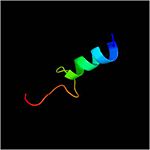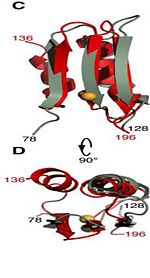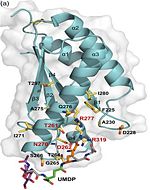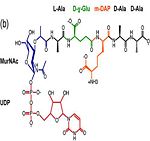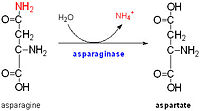Mycobacterium tuberculosis ArfA Rv0899
From Proteopedia
(Difference between revisions)
| Line 5: | Line 5: | ||
The deletion of this gene impairs the uptake of some water-soluble substances, such as serine, glucose, and glycerol. | The deletion of this gene impairs the uptake of some water-soluble substances, such as serine, glucose, and glycerol. | ||
| - | ==Peptidoglycan binding site== | ||
== Structural highlights == | == Structural highlights == | ||
| Line 45: | Line 44: | ||
Two M. tuberculosis H37Rv genes (Rv0900 and Rv0901) adjacent to Rv0899 also encode putative membrane proteins, and are found exclusively in association with Rv0899 in the same pathogenic mycobacteria, suggesting that the three may constitute an operon dedicated to a common function. The operon is necessary for rapid ammonia secretion and adaptation of M. tuberculosis to acidic environments in vitro but not in mice. | Two M. tuberculosis H37Rv genes (Rv0900 and Rv0901) adjacent to Rv0899 also encode putative membrane proteins, and are found exclusively in association with Rv0899 in the same pathogenic mycobacteria, suggesting that the three may constitute an operon dedicated to a common function. The operon is necessary for rapid ammonia secretion and adaptation of M. tuberculosis to acidic environments in vitro but not in mice. | ||
Asparagine is the primary ammonia source for Mycobacterium tuberculosis H37Rv at acidic pH <ref>PMID: 21410778 </ref>. The amino acid pair <scene name='61/612805/Asn111_and_gly112/1'>Asn111-Gly112</scene>,located at the end of α1 and preceding L3, undergoes in-vitro deamidation, a pH-dependent reaction whereby Asn is converted to Asp and ammonia is released. Asparagine residues preceding glycine, and situated in conformationally flexible regions of proteins, are frequently deamidated, with potentially significant consequences for protein regulation and function. In the case of Rv0899, deamidation and the concomitant release of ammonia could have important consequences for the acid adaptation function of the protein. <ref>PMID: 20199110</ref> | Asparagine is the primary ammonia source for Mycobacterium tuberculosis H37Rv at acidic pH <ref>PMID: 21410778 </ref>. The amino acid pair <scene name='61/612805/Asn111_and_gly112/1'>Asn111-Gly112</scene>,located at the end of α1 and preceding L3, undergoes in-vitro deamidation, a pH-dependent reaction whereby Asn is converted to Asp and ammonia is released. Asparagine residues preceding glycine, and situated in conformationally flexible regions of proteins, are frequently deamidated, with potentially significant consequences for protein regulation and function. In the case of Rv0899, deamidation and the concomitant release of ammonia could have important consequences for the acid adaptation function of the protein. <ref>PMID: 20199110</ref> | ||
| - | + | ==Peptidoglycan binding site== | |
[[Image:Asparaginase-reaction.jpg|200px]] | [[Image:Asparaginase-reaction.jpg|200px]] | ||
Revision as of 16:09, 21 January 2015
| |||||||||||
